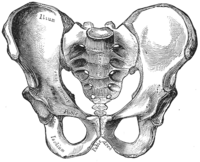
Photo from wikipedia
Background A femoral nerve injury may result in cutaneous sensory disturbances of the anteromedial thigh and complete paralysis of the quadriceps femoris muscles resulting in an inability to extend the… Click to show full abstract
Background A femoral nerve injury may result in cutaneous sensory disturbances of the anteromedial thigh and complete paralysis of the quadriceps femoris muscles resulting in an inability to extend the knee. The traditional mainstay of treatment for femoral neuropathy is early physiotherapy, knee support devices, and pain control. Case reports have used the anterior division of the obturator nerve as a donor nerve to innervate the quadriceps femoris muscles; however, a second nerve transfer or nerve grafting is often required for improved outcomes. We suggest a novel technique of combining an innervated, pedicled gracilis transfer with an adductor longus to rectus femoris nerve transfer to restore the strength and stability of the quadriceps muscles. Methods This is a case series describing the use of a pedicled gracilis muscle transposed into the rectus femoris position with a concomitant nerve transfer from the adductor longus nerve branch into the rectus femoris nerve branch to restore quadriceps function after iatrogenic injury (hip arthroplasty) and trauma (gunshot wound). Results With electrodiagnostic confirmation of severe denervation of the quadriceps muscles and no evidence of elicitable motor units, 2 patients (average age, 47 years) underwent a quadriceps muscle reconstruction with a pedicled, innervated gracilis muscle and an adductor longus to recuts femoris nerve transfer. At 1 year follow-up, the patients achieved 4.5/5 British Medical Research Council full knee extension, a stable knee, and the ability to ambulate without an assistive aid. Conclusions The required amount of quadriceps strength necessary to maintain quality of life has not been accurately established. In the case of femoral neuropathy, we assumed that a nerve transfer alone and a gracilis muscle transfer alone would not provide enough stability and strength to restore quadriceps function. We believe that the restoration of the quadriceps function after femoral nerve injury can be achieved by combining an innervated, pedicled gracilis transfer with an adductor longus to rectus femoris nerve transfer with low morbidity and no donor defects.
Journal Title: Annals of Plastic Surgery
Year Published: 2022
Link to full text (if available)
Share on Social Media: Sign Up to like & get
recommendations!